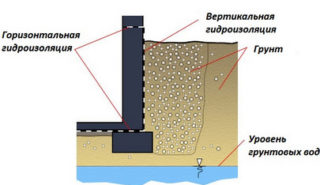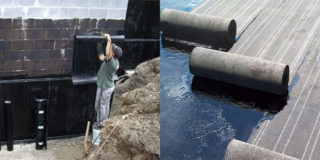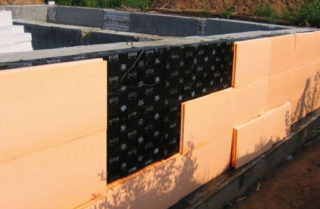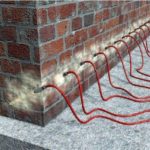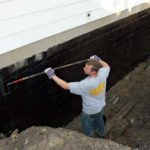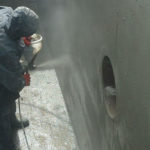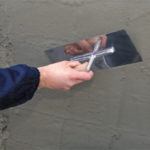Building materials under the constant influence of dampness lose their performance characteristics and over time are completely destroyed. Waterproofing the basement slab of a residential building or utility structure allows you to eliminate this danger, to create a comfortable, dry and healthy microclimate in the room. The event is not particularly difficult and can be performed even by a beginner in construction. To achieve the desired result with a long-term positive outlook, you need to familiarize yourself with the commercially available insulation materials and the technology for their use.
Impact of moisture on the foundation
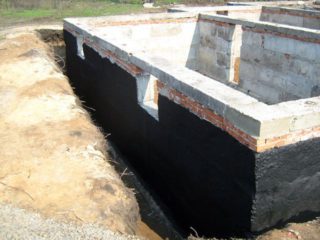
In almost any type of construction, the construction of the foundations of buildings is carried out from concrete. In the absence of high-quality insulation, the strip, columnar and even monolithic foundation will very quickly fall into disrepair.
The dangers of concrete contact with water are as follows:
- The material has a capillary structure. Moisture enters the pores and gradually saturates it throughout the volume. Sooner or later, dampness reaches the interior walls, finishes and coatings. All this leads to the development of the decay process, the appearance of fungus and mold.
- Any foundation contains a metal frame, which is made of black, corrosive iron. On contact with water, rust forms on it, as a result of which the volume of the metal increases by 2-3 times. The resulting internal stress leads to the destruction of the basement and the walls of the basement.
- When cooled below the freezing point, the water contained in the material begins to expand and literally tears it apart from the inside. Because of this, the base, once stone in its strength, turns into dust, stuffed with rusty and weakened reinforcement.
- Groundwater is saturated with salts, alkalis and acids. These substances are corrosive to concrete. Its surface is gradually covered with caverns and shells, slowly becoming thinner.
Waterproofing a foundation slab is a necessary procedure on which the comfort of staying in a building and its durability depend.
From what and how should the foundation be protected
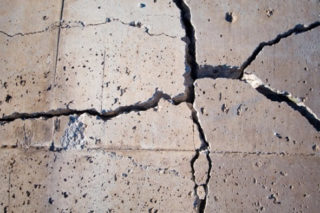
Water is a necessary component of concrete only at the stages of mixing the solution and its hardening, which occurs over 28 days. In the process of crystallization, the surface is wetted so that the process of moisture evaporation occurs simultaneously throughout the entire volume of the block. After the material gains strength, water becomes harmful to it. Based on this, finishing activities should be carried out immediately after the base has hardened, without waiting for it to begin to damp and deteriorate.
It is necessary to waterproof the foundation to protect against such phenomena:
- Leakage. Even a thick slab is gradually saturated with moisture and, under external pressure, passes it inside the premises. The influx can be so strong that it will flood the subfloor to the basement level.
- Aggressive substances contained in groundwater. They are dangerous for the entire structure as a whole, as they weaken the supporting structure, corroding its surface.
- Swelling of the material with moisture.With prolonged stagnation, water provokes the growth of pathogenic microorganisms, causes corrosion of the metal.
There are several ways to prevent moisture from contacting the base of a building. They differ in place and time, labor intensity and effectiveness of the final result.
The approaches can be as follows:
- Arrangement of a wide and sealed blind area around the house. With a width of 200 cm or more, a waterproof strip along the structure will prevent rain and melt water from entering the ground.
- Application of insulating materials outside. This is the most practical way to protect most of the substrate from moisture. This activity can be carried out at any stage of the operation of the structure, but it is better to perform it immediately in order to avoid time-consuming earthworks after backfilling.
- Finishing from the inside. The process is simple and always available, but its effectiveness is extremely low, since the outer part of the foundation remains unprotected and is exposed to the destructive effects of moisture. Applying insulation to the inner walls of the basement allows you to seal the surface, seal the cracks that appear and prevent flooding.
When arranging a slab base, it is advisable to use lower insulation with the edges of the canvas leading to the upper part of the slab. However, this process must be thought out even at the design stage, since after pouring the lower part of the base becomes inaccessible.
Types of waterproofing
The choice of insulation type is determined by several factors. The calculation takes into account the type and complexity of the foundation, the depth of its foundation, the ability to access the external walls. There are different techniques and a wide range of materials for waterproofing.
- Horizontal waterproofing. It is carried out during the construction phase until the moment the blocks are laid or the concrete is poured. Used roll and bulk materials, dense clay or a special grade of waterproof concrete, which includes plasticizers. Also, the method is used to protect the upper surfaces of the foundation from moisture in those places where walls, columns and other supporting structures are being erected.
- Vertical. This technology is applied to already erected structures after their complete hardening. Waterproofing materials for foundations are selected based on the features, configuration of structures and the expected conditions of their operation.
- Coating room. The method is the application of waterproof compounds to the walls of the bases using brushes and rollers. To protect concrete, one-component and two-component resins and mastics are used on a polymer, bitumen-polymer and bitumen-rubber base. The coatings retain their elasticity even at negative temperatures, and are reliable protection against moisture and active reagents.
Roll-up waterproofing Roll. Wall treatment is carried out by applying a flexible waterproof material sold in rolls to them. Fixation to the surface is carried out using glue or fusion. If earlier roofing material was widely used, now it is being replaced by more technologically advanced and durable materials. The waterproofing of the foundation Technonikol, Gidroizol, Bikrost and Linokrom is very popular with private developers. The products are particularly reliable, but their price is also quite high.
- Painting and plastering. The finish is applied with a spatula and, after hardening, forms a durable hermetic layer with an aesthetic surface. It is more often used to protect the basement level in order to level it and give it an attractive look. For flat surfaces, special types of paints are used, combining flexibility and the ability to impregnate concrete by a few millimeters. Along the way, the assembly of the steel gas pipeline running along the wall of the building may be painted. The technology is inexpensive, easy to implement, but short-lived.
Installation of waterproofing mats Mounted. Here, external installation of panels or mats is used, the basis of which is refined clay. The slabs are screwed to the foundation, after which, under the influence of external pressure, the clay adheres to the concrete, forming a dense and sealed layer. The use of this technology requires a lot of labor and therefore is rarely used. In addition, time must pass until a strong contact between the mats and the foundation occurs.
- Penetrating. This method is more often used for interior work, if the waterproofing stage from the outside was missed during the construction phase. The essence of the technology lies in the penetrating properties of the material. The liquid permeates concrete to a depth of 15-25, after which it crystallizes and tightly clogs all the pores and capillaries. The product is expensive, the effectiveness of the result is achieved by strict adherence to the instructions for use.
- Injection. This technology is used in emergency situations associated with the occurrence of leaks in the foundation. A special feature of the injection substance is the possibility of its application to raw concrete. After penetrating into the cavities, it solidifies, forming an airtight layer up to 20 cm thick. At the same time, the outer part of the foundation continues to collapse under the influence of dampness and reagents.
The correct choice of waterproofing technology is determined by the analysis of the foundation, the degree of its damage, the composition and moisture content of the soil, and the estimated service life of the building.
Waterproofing materials
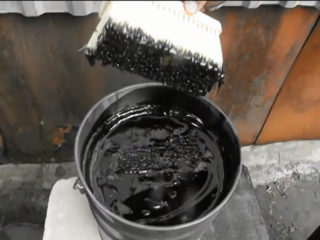
To make a reliable and durable waterproofing of a house foundation, it is necessary to select the material that is best suited for specific conditions. To do this, you need to know the features, advantages and disadvantages, application technology and maintenance of all commercially available products. In some cases, it is worth familiarizing yourself with the assortment of online stores, since a limited number of products are always presented in retail outlets. It is difficult to find expensive materials even in specialized supermarkets.
One of the criteria for choosing waterproofing is the moisture content of the concrete. The exception applies only to injection solutions, which are intended specifically for repair work on raw materials. In other cases, the degree of moisture saturation of concrete should not exceed 4% for organic primers and 8% for water-soluble ones. An excellent solution for both options is TechnoNIKOL primer. The material consumption is 300 ml / m² of surface, which allows you to keep within a reasonable budget.
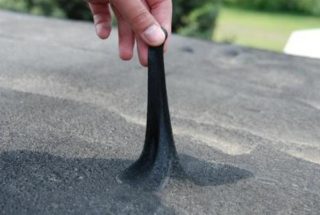
Depending on the working conditions, the following types of insulating materials are selected:
- Bitumen. This substance has been used in construction for more than a decade, being popular due to its affordable price, ease of use and a rather long service life. Before application, bitumen is melted and spread on the walls. Used engine oil is added to make it elastic.
- Liquid rubber. It is sprayed onto the surface with a spray gun, creating a seamless, sealed coating. The disadvantage of the material is its softness, it can be damaged by backfilling. To prevent this, the insulation is covered with shields or nets.
- Roofing material and its analogs with a polymer-coated base. The tightness of modern materials is achieved by using bitumen mastics applied to a solid base made of fiberglass or polyester. Such coatings are characterized by increased strength and good elasticity.
Not only external, but also internal surfaces should be processed. Given the area and configuration of the base, different types of materials can be used by intelligently combining different technologies.
DIY foundation waterproofing technology
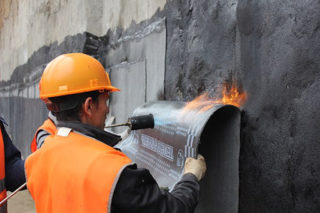
To protect the base of the building from dampness, TechnoNIKOL waterproofing for the foundation will help. It is a modern material that combines high performance at an affordable price. It is sold in rolls of 10x1 m format. With excellent adhesion and absolute waterproofness, the insulator is so light that you can work with it without the assistance of an assistant. The adhesive surface ensures reliable adhesion. It is not necessary to use a torch or adhesive mixtures.
The work should be carried out in the following sequence:
- Remove protruding fragments from the surface. Clean them of dust, dirt, oil stains and old finishes. If there are large chips or gouges, seal them up with cement mortar. Proceed in the same way with the seams between the FBS. The solution must be removed from them and re-sealed with polymer filler.
- Treat concrete with TechnoNIKOL primer. One pass is enough, since the liquid is absorbed into the base and leaves a thin and strong film on its surface, tightly bound to the concrete.
- Prepare outside corners. Strips should be glued to their sharp edges or a plastic semicircular profile should be used to prevent material tearing during installation and during operation.
- Make a markup in the form of vertical lines indicating the boundaries of each strip. Check their exact vertical passage.
- Roll out the roll, fix it on the top of the foundation, having previously unscrewed the protective film. Gradually peeling off the backing and following the markings, glue the first strip. After reaching the base of the wall, cut the roll and secure the lower part.
- Paste over the rest of the foundation in the same way.
The final step is gluing the seams between the strips. Aluminum tape is best suited for this.

